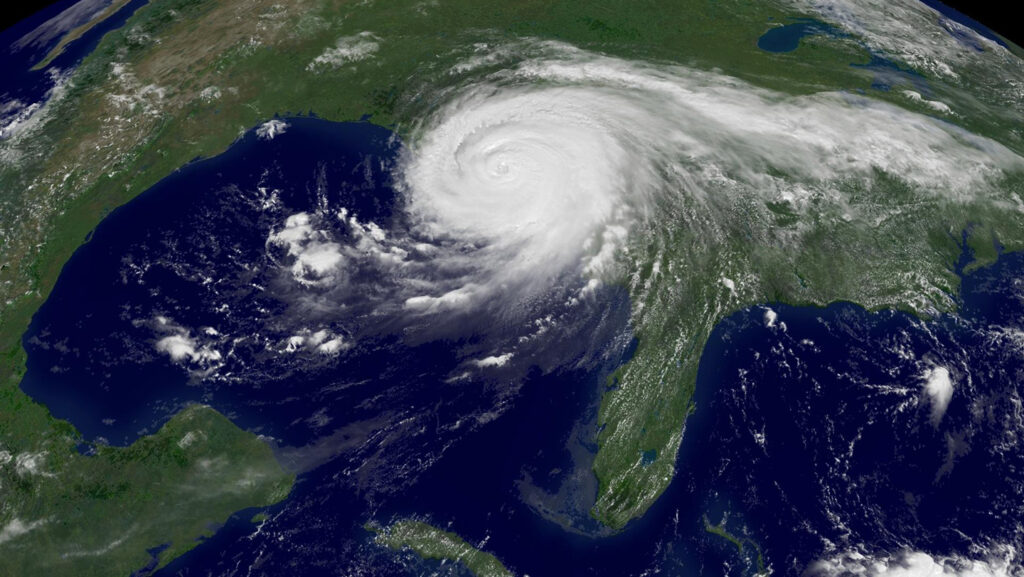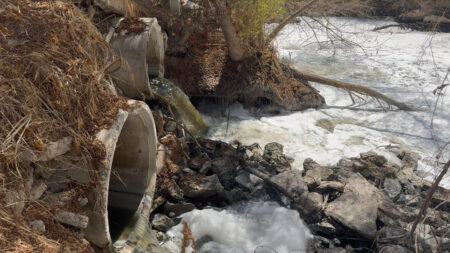In late August 2005, Hurricane Katrina devastated the U.S. Gulf Coast. The storm cut a deadly swath through Louisiana, Mississippi and Alabama, deluging coastal towns as surges of ocean water swept relentlessly ashore, driven by powerful winds. The sheer force of the surging waters overpowered levees meant to protect low-lying New Orleans from floodwaters; the levees failed, and about 80 percent of the city was inundated.
In all, the hurricane caused more than 1,800 fatalities, displaced hundreds of thousands of people from their homes and was responsible for about $125 billion in property damage. It’s one of the two costliest Atlantic hurricanes on record, tied with 2017’s Hurricane Harvey.
The scale of the devastation from Katrina also shoved the question of the country’s readiness for such a catastrophic event into a glaring spotlight. The event highlighted critical gaps in hurricane forecasting and modeling, including how quickly a storm system can spin up into a major hurricane, and how much ocean water its winds drive onto the shore, a phenomenon called storm surge.
The response to the disaster was also worrisome. Federal aid to the region was slow, uncoordinated and insufficient; evacuation orders came less than a day before landfall, too late for many residents, and there was not enough shelter, food or water for those left stranded.
The Federal Emergency Management Agency, part of the Department of Homeland Security, was “overwhelmed” by the scope of the disaster, then-Homeland Security director Michael Chertoff told a Senate investigating committee in February 2006. “It is completely correct to say that our logistics capability … was woefully inadequate.”
Significant anniversaries of a disaster can bring fresh attention to the event, creating “a policy window when people are paying attention,” says Andrew Rumbach, a researcher who studies the impacts of climate change and disasters with the nonprofit Urban Institute, based in Washington, D.C. “I think 20 years is a good time to really reflect on what has happened and what will happen in the future.”
In those two decades, there have been big leaps in forecasters’ ability to determine where a hurricane will go and how powerful it will get — advances that can both save lives and reduce the punishing price tag of such catastrophes. But recent policy shifts in the national response to hurricane research and preparedness might counteract those gains, researchers say.
Taken together, it’s not at all clear that the country is better prepared for another Katrina.
The genesis of a hurricane disaster
Katrina was one of 27 named storms in the Atlantic Ocean in 2005, a then-record-breaking season fueled by high ocean temperatures and fostered by favorable patterns of wind and air pressure.
On August 25, Katrina was a Category 1 hurricane in the Atlantic. After making landfall in southeastern Florida, the storm brushed across the peninsula, aiming for the Gulf of Mexico.
The National Weather Service forecast that the storm would then curve north back toward the Florida panhandle for a second landfall. Instead, Katrina kept moving west over the Gulf, pulling in a ready supply of heat and moisture from a 100-meter-thick layer of water averaging 26 degrees Celsius.
Within a day, the storm suddenly strengthened into a major Category 3 hurricane, with winds up to 185 kilometers per hour. On August 28, Katrina rapidly intensified again: Over 12 hours, the wind speeds increased from 185 kilometers per hour to 265 kilometers per hour.
Hitting Category 5 hurricane status, the storm finally turned north toward Louisiana.
Have forecasts improved since Katrina?
The two great challenges of hurricane forecasting are predicting where a storm will go and how strong it will get. And both types of forecasts have improved dramatically over the last half-century, noted MIT atmospheric scientist Kerry Emanuel and colleagues in 2019 in Science.
Part of that improvement comes from better and more frequent observations, particularly from satellite remote sensing that offers abundant data on atmospheric conditions multiple times a day. And the rest comes from faster and more powerful computers as well as a better understanding of atmospheric physics and dynamics — which makes it possible to take those observations and feed them into climate system computer models that can predict the likeliest fates for these storms.
Researchers have deployed a variety of methods to collect real-time observations of a storm’s wind speeds and other characteristics, including Hurricane Hunter plane flights into storms, autonomous gliders that collect ocean measurements of heat and salinity, and the Defense Meteorological Satellite Program, which helps identify changes to storm intensity and structure.
Such real-time data is particularly important when it comes to anticipating whether and when a storm system might rapidly organize itself and suddenly intensify into a major hurricane, as Katrina did in the Gulf.
Hurricane Hunter planes that fly into storms and collect data from within the maelstrom have significantly increased the accuracy of the track forecasts, researchers reported in July in Weather and Forecasting. The researchers analyzed errors on forecast tracks before and after surveillance missions into storms from 2018 to 2022. Those improvements, the researchers suggest, may have come from better knowledge of the position of the storm, and better understanding of the winds steering the storm’s direction — reducing forecast track errors by as much as 24 percent.
Satellite data has also provided data crucial to more accurate forecasts. NOAA satellites, such as the GOES-16 satellite that went online in 2017, began providing increasingly high-resolution images of the top cloud layer. And the Department of Defense’s constellation of weather satellites, which observe Earth using the microwave portion of the electromagnetic spectrum, are able to penetrate the clouds, offering information on temperature, moisture and precipitation. All of these data make it possible to see inside a storm, assess its structure, and determine the likelihood of its strengthening.
Researchers also recognized that improving computer models would be key to reducing forecast errors and providing more accurate warning. So, in the wake of the Atlantic Ocean’s hyperactive, deadly and costly 2004 and 2005 hurricane seasons, in 2007 the National Hurricane Center initiated the Hurricane Forecast Improvement Project, a collaboration among numerous agencies and labs to make hurricane track and intensity forecasts — as well as forecasts of storm hazards such as storm surges — more accurate and more reliable — and give communities in their potential path more time to prepare.
The ambitious goal of the project was to improve forecast tracks by 50 percent. That goal has been more than met, says Jeff Masters, a hurricane scientist who flew with the NOAA Hurricane Hunters from 1986 to 1990. “Track forecasts have seen a huge improvement since 2005, with track errors for all lead times improved by about 50 percent, to well over 50 percent.”
For example, in the 2000s, forecasts for where a hurricane might go within four days could be off by over 300 kilometers — about the distance from the Florida panhandle to New Orleans. Today, the errors on a 4-day track forecast have shrunk to around 200 kilometers, according to data from NOAA’s National Hurricane Center.
That means that “a situation like we had in 2005 with the track of Katrina suddenly shifting 200 miles for NHC forecasts issued 12 hours apart is much less likely to occur,” Masters says. “This will give people more time to prepare, increasing the odds of lower death tolls and damages.”
Intensity forecasts, too, have made great strides. In 2022, NOAA announced its “next-generation” hurricane model, the Hurricane Analysis and Forecast System, which is able to track multiple active tropical storms at the same time. That allows researchers to better observe how these storms influence one another, something that has previously been difficult to incorporate into computer models. This way of tracking simultaneous storms can improve predictions of a particular storm’s future intensity by as much as 30 percent, researchers reported in the Bulletin of the American Meteorological Society.
Do better forecasts reduce the costs of storms?
Four days isn’t a lot of time for big damage-preventing strategies, such as building back protective wetlands or raising seawalls. But it is enough time for federal, state and local governments to take some protective actions, such as evacuating communities in the path of the storm, installing temporary levees or deploying emergency generators to hospitals. And this accelerated improvement in U.S. forecasts has already translated not only to lives saved but also to less costly storms.
An analysis of the economic impact of over 30 land-falling hurricanes in the U.S. between 2005 and 2022 suggests that improved forecasts beginning around 2007 — the result of the Hurricane Forecast Improvement Program, or HFIP — reduced the price tag of later hurricanes by 19 percent, or about $2 billion. By comparison, the cost of the hurricane forecast improvement program, from 2009 to 2019, was only about $300 million, says environmental and natural resource economist Renato Molina of the University of Miami, who coauthored the study.
The data show that HFIP was an unmitigated success, Molina says. “You rarely see those kinds of returns” in a government program, he says. “It’s top notch. There’s nothing I can say that’s negative about the program.”
But the picture isn’t entirely rosy. Climate change could erase much of these gains by reducing the forecastability of hurricanes in the future, Molina says. Hurricanes are becoming more dangerous as Earth’s climate warms: bigger, rainier, penetrating farther inland — and, increasingly, explosively and swiftly intensifying into major storms, fueled by rising ocean water temperatures.
A Climate Central analysis of tropical cyclone intensification rates from 1971 to 2020 shows that the number of Atlantic storms that quickly intensified from a Category 1 to a Category 3 or higher hurricane within 24 hours more than doubled in that time. Warm ocean waters are a leading culprit: Sea surface temperatures in the Gulf of Mexico have increased by about 1 degree Celsius since the 1950s. The Atlantic Ocean’s very warm waters juiced up devastating hurricanes Harvey and Maria in 2017.
What would really reduce the future costs of hurricanes, Molina says, would be for the United States to commit to long-run adaptations, like seawalls and wetland restoration, against the likelihood of future hurricane impacts. Such adaptations, he and colleagues determined, could double the amount saved per hurricane.
Forecast progress may be in jeopardy
On the heels of its success, the HFIP now has set itself new goals to provide even more lead time for forecasts. Those include creating computer simulations of the structure of a storm’s inner core seven days out from its landfall and lengthening the lead time for forecasts of a hurricane’s wind speed, rapid intensification, storm surge and rain.
But looming cuts to NOAA’s budget threaten many of the gains, potentially eliminating funding for satellites, storm observations and staff. The future of the Hurricane Hunter program is uncertain, with many of its staff eliminated in early 2025. The Department of Defense announced that it would no longer provide its weather satellite data to NOAA as of June 30; that decision was later reversed and postponed to September 2026. What will happen to that satellite data after that date remains unclear. The administration’s proposed budget would reduce support for researchers at labs that work on computer simulations, including at the National Center for Atmospheric Research and at Princeton University.
The Trump administration has also proposed dramatic cuts to the Federal Emergency Management Agency, including the possibility of eliminating it altogether.
On August 25, 191 current and former FEMA employees — only 35 of whom attached their names, for fear of retaliation — signed the “Katrina Declaration,” an open letter to Congress to “sound the alarm” that the agency’s “current trajectory reflects a clear departure” from efforts made in the wake of that disaster not to repeat the agency’s shortcomings. On August 27, FEMA suspended more than 20 employees who had signed the letter.
As climate change increases the frequency and severity of hazards, annual losses due to disasters is projected to double in many countries around the Gulf Coast by 2050. A study by the Urban Research Institute, using data from the U.S. Federal Emergency Management Agency’s Future Risk Index, found that Gulf Coast states are projected to lose $32 billion per year under a “middle-of-the-road” warming scenario, compared with $15 billion if global warming is not considered.
A repeated barrage by storms makes recovery particularly challenging, Rumbach says. “A large part of the Gulf has gotten hit again and again and again. It’s really difficult to recover once. It’s more difficult to recover multiple times.”
The data clearly show that it makes sense to continue our investments in hurricane research, “which have brought about these huge advancements in forecast accuracy,” Masters says. “But given the multiple losses in forecasting capability that have occurred this year, this progress may halt or even reverse beginning in 2025.”
And that’s particularly untimely, he says, because climate change is increasing the odds that hurricanes will rapidly intensify, many just before landfall, giving little time to coastal communities to prepare or evacuate. “These are the most dangerous types of hurricanes.”
Read the full article here

















